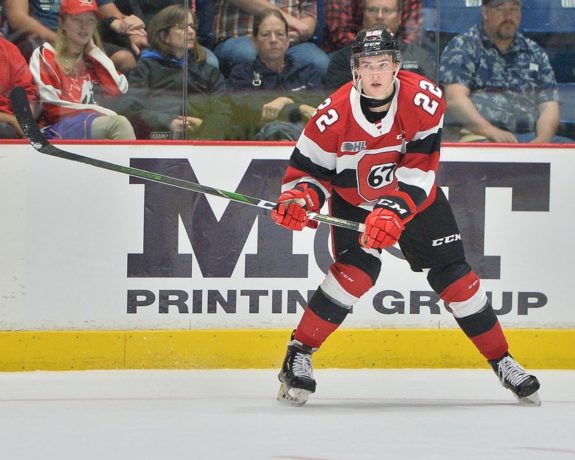Buffalo Sabres prospect Jack Quinn was viewed as a questionable selection at eighth overall in the 2020 NHL Draft. Many scouts believed that he wasn’t even the best prospect on his team, as Marco Rossi was seen as a player with a higher upside. Those opinions wouldn’t change over the coming months. After playing for Team Canada at the U20 World Junior Championships, his performance left a lot to be desired. He scored one goal and five points in seven games, and that production wasn’t terrible, but he was playing on Canada’s top-6 forward lines. For a team that was viewed as one of the best-constructed groups in the past decade, they disappointed, and Quinn was a part of that.
Now, coming into the season, Quinn was able to play for Rochester Americans in the American Hockey League (AHL) as the start of the Ontario Hockey League season was delayed. With many top prospects not being able to find a place to play, they were granted permission to play for their NHL teams’ minor league affiliates. This was a unique opportunity to allow Quinn to play against professional hockey players, and he didn’t look out of place.
In this article, I will dive into Quinn’s performance throughout his play in Rochester and what the analytics suggest about his play.
Jack Quinn Played Better Than Expected
Throughout 15 games, Quinn scored two goals and had nine points in 15 games. Compared to other 19-year-olds in the AHL, his 0.6 points per game (P/PG) put him into the top-45 in league history for players with at least 15 games played. Rochester has struggled this season, putting up a record of 8-9-2 and ranking fifth in the North Division, but Quinn’s play is not why the team is struggling. He has showcased his lethal shot and his creativity with the puck.

Looking at his goal against the Syracuse Crunch, Quinn displayed his puck protection to drive to the net and roof a backhand shot on the power play. Instead of firing a low-percentage shot, he made the harder play of cutting to the middle of the ice and outskated the two players defending him. If he can make plays like this against NHL players, he will carve out a successful career for himself.
Related: Sabres’ Young Core Providing Reason for Optimism
The Americans head coach, Seth Appert, addressed the media following the announcement of Quinn’s season-ending surgery, and said, “the kind of young man he is and how he treats his teammates is awesome.” He has always been known as a player with good character, and his teammates love him. As much as these characteristics can be overlooked in hockey, the Sabres need more of these player types on their roster. They need to enjoy playing hockey.
How Did His Underlying Numbers Look?
As mentioned earlier, it was surprising when the Sabres selected Quinn with their eighth-overall selection. He was viewed as a player that should have went in the mid-first, as opposed to the top 10. Rossi was seen as a potential top-5 talent, and it was shocking to see him drop to the Minnesota Wild at ninth overall. The visualization featured below is from HockeyProspecting.com. Their model uses scoring numbers from junior leagues worldwide and uses historical performances to chart how a prospect will perform at the NHL level. For the example below, Rossi has an 82 percent chance of becoming a star player in the NHL, while Quinn only has a 27 percent chance. It’s a reliable tool for evaluating prospects.
Now, let’s take a look at his numbers from the AHL. Chad DeDominicis manually tracks various stats for the Americans throughout the course of the season. The two metrics used for looking at Quinn’s on-ice impact are 5v5 primary shot contributors and 5v5 high-danger chance rate. Regarding his primary shot contributions, Quinn ranked 17th out of all skaters with Rochester. For context, Arttu Ruotsalainen ranked first out of all skaters on the team. In terms of his high-danger chance rate, he ranked 20th out of all skaters. The underlying numbers suggest that he looked below average on his own team in various metrics.
On the contrary, his finishing ability cannot be understated. He contributed as a 19-year-old forward and even played center the last few games before his injury. He will likely have to play with the Ottawa 67’s next season in the OHL, as he won’t be AHL eligible if he can’t make the Sabres full-time. There is no reason to rush this player, as he will likely become a solid top-6 contributor. He doesn’t drive play, but he will be able to finish plays if he is playing with a center like Jack Eichel. This kid has potential.